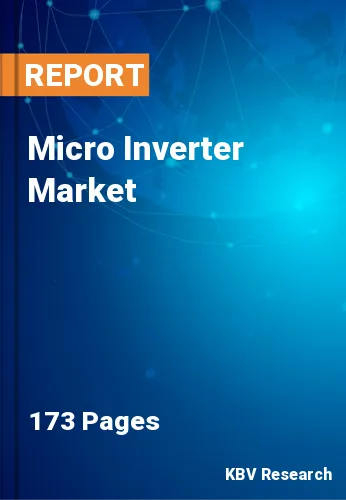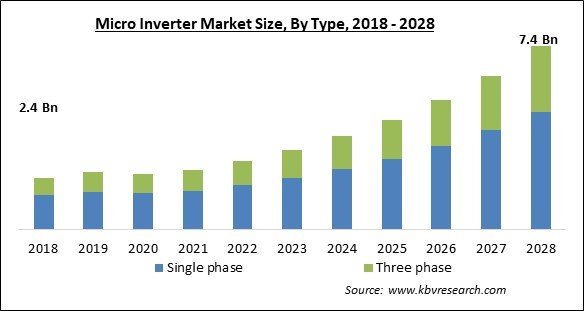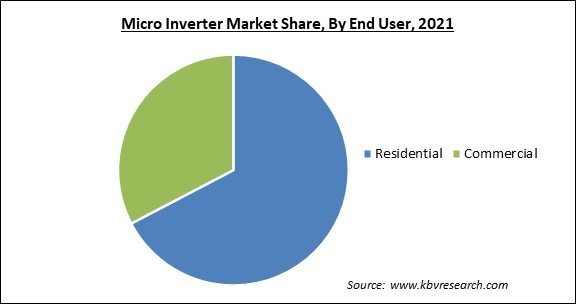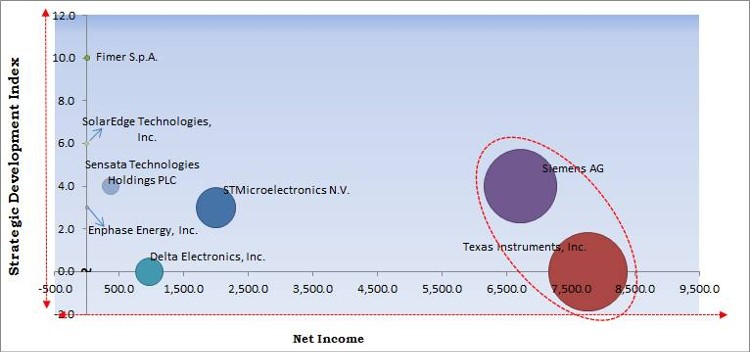
The Global Micro Inverter Market size is expected to reach $7.4 billion by 2028, rising at a market growth of 17.8% CAGR during the forecast period.
In photovoltaic systems, a micro inverter is an electrical device that transforms direct current (DC) from solar modules into alternating current (AC). To convert DC electricity to AC power at the device power source, such inverters are generally mounted separately on each solar panel. In addition, when compared to central inverters and string inverters, a micro inverter is simple to install and operate. Additionally, by conducting maximum power point tracking (MPPT) for the connected module, it aids in the production of optimal power. Moreover, it has various advantages over standard inverters, including increased dependability, higher output, and improved safety.
Technical benefits over other traditional solar inverters, capabilities, and design flexibility, such as generating maximum power from solar panels are driving the micro inverter market ahead. Additionally, the market is expected to develop due to an increase in demand for sustainable and clean energy as a result of rising concerns about greenhouse gas emissions. There is an increase in the frequency of solar photovoltaic (PV) installations for various applications around the comprehensive market.
When first firefighters or responders are on rooftops or maintaining power lines, new electrical rules require speedy solar system shutdown to keep them safe from high voltage. Such rapid shutdown needs are met by micro inverters, which have this functionality built into each module. The main benefit of employing micro-inverters is that firefighters can theoretically generate more solar electricity. The basis for this is that the currents across solar panels differ slightly. When solar panels are joined in a string, the current is reduced to the least-generating panel in the string.

The COVID-19 pandemic has an overall influence on society and the economy. The COVID-19 pandemic has had a significant impact on the electronics and semiconductor industries. Due to an increase in the number of COVID-19 cases, manufacturing and business units in several nations were closed. Additionally, the partial or complete shutdown impacted the worldwide supply chain, making it difficult for manufacturers to access customers and raw materials.
Additionally, this pandemic has had an influence on the electronics industry, as production facilities have halted, boosting demand for semiconductor and electronics products in the businesses. Its main effects include a significant manufacturing halt in Europe and a halt in Chinese parts exports, both of which limit the micro-inverter market's potential.
Micro-inverters provide a number of technical advantages over other types of solar inverters, such as string and central inverters. Micro-inverters are located beneath each solar panel and convert direct current (DC) power produced by a single solar panel, contrasting conventional inverters, which are positioned at a distance from the solar array and can run and monitor a number of solar panels at the same time. This allows users to work independently. The photovoltaic (PV) system's maximum potential output is delivered by the micro-inverter. The ability of micro-inverters to sustain the consistent and strong flow of power amidst the shading of one or more of their panels is their prime advantage, which has increased their popularity among end-users.
Rapid advancements in the solar energy sector in order to power generation and use are helping to boost the number of solar PV installations for diverse applications around the world. For instance, as per Solar Power Europe's research, the Global Market Outlook for Solar Power/2020–2024, a numerous amount of countries installed above 1 GW of solar panels in 2019, which is in 2018, there were 5 GW of solar panel installations, up from 11 GW in same year. There has been a substantial increase in the number of new solar installations in recent years. Inverters have a greater penetration potential in new solar systems than it is done in existing or ongoing solar installations.
The solar micro inverter solely depends on the balance and required amount of solar energy that is provided by sun. However, it is Some days it will be sunny, cloudy, and rainy or other kind of whether condition. Hence, in such conditions where micro inverter would not be able to perform to its maximum capacity, and in such scenario many operational activities that depend on micro inverter would come to temporary halt, and ultimately hamper the overall performance of the organization. Even during the sunny days, the level of sunlight may differ and create a probable variability in performance of the micro inverter.

Based on Type, the market is segmented into Single phase and Three phase. The single-phase inverter segment acquired the highest revenue share in the micro-inverter market in 2021. Due to their modular nature, plug-and-play capability, and control flexibility, single-phase micro-inverters have become increasingly popular in grid-connected residential PV systems. Such inverters are equipped with power decoupling capabilities to prevent pulsing output power from being reflected on PV outputs. There is an increase in the usage of an intermediate capacitor for power decoupling in a single-stage buck-boost derived PV micro-inverter. The transformer-free doubly grounded architecture eliminates common mode ground current problems.
Based on Connection, the market is segmented into Grid Connected and Stand Alone. The standalone segment witnessed a significant revenue share in the micro-inverter market in 2021. Due to the tiny size, which eliminates the need for an electrolyte capacitor and large transformer, standalone systems would record a significant popularity throughout the projection period. To stay in business, many market participants are focusing on R&D, production, and installation.
Based on End User, the market is segmented into Residential and Commercial. The residential segment recorded the largest revenue share in the micro-inverter market in 2021. Solar photovoltaic adoption is expanding in the residential sector, owing to anticipated cost reductions, the requirement for a substitute origin of electricity, and the intention to decrease climate change risk. As a result, the micro inverter market's growth prospects have improved. The share of rooftop solar PV is expected to grow during the forecast period due to lower solar PV costs, favorable government policies for residential solar PV, FIT programs & incentives, and solar energy targets set by various governments. Continuous technological advancements, such as improved solar PV module efficiencies, are driving cost reductions.
| Report Attribute | Details |
|---|---|
| Market size value in 2021 | USD 2.4 Billion |
| Market size forecast in 2028 | USD 7.4 Billion |
| Base Year | 2021 |
| Historical Period | 2018 to 2020 |
| Forecast Period | 2022 to 2028 |
| Revenue Growth Rate | CAGR of 17.8% from 2022 to 2028 |
| Number of Pages | 173 |
| Number of Tables | 322 |
| Report coverage | Market Trends, Revenue Estimation and Forecast, Segmentation Analysis, Regional and Country Breakdown, Competitive Landscape, Companies Strategic Developments, Company Profiling |
| Segments covered | Type, Connection, End User, Region |
| Country scope | US, Canada, Mexico, Germany, UK, France, Russia, Spain, Italy, China, Japan, India, South Korea, Singapore, Malaysia, Brazil, Argentina, UAE, Saudi Arabia, South Africa, Nigeria |
| Growth Drivers |
|
| Restraints |
|
Based on Regions, the market is segmented into North America, Europe, Asia Pacific, and Latin America, Middle East & Africa. The Asia Pacific emerged as the leading region in the micro-inverter market with the largest revenue share in 2021. The presence of many nations such as Japan, China, Australia, and India are striving to increase their solar PV installation capacity via sophisticated solar PV systems, which might improve electric stability. For commercial, residential, and PV power plant applications, APAC has multiple operating micro-inverter installations. Micro-inverter technology has been widely adopted in Japan and Australia. In addition, the growing number of residential rooftop solar PV installations in Japan and India motivates manufacturers to meet the needs of potential clients in the countries.
Free Valuable Insights: Global Micro Inverter Market size to reach USD 7.4 Billion by 2028

The major strategies followed by the market participants are Product Launches. Based on the Analysis presented in the Cardinal matrix; Siemens AG and Texas Instruments, Inc. are the forerunners in the Micro Inverter Market. Companies such as STMicroelectronics N.V, Sensata Technologies Holdings PLC, SolarEdge Technologies are some of the key innovators in the Market.
The market research report covers the analysis of key stake holders of the market. Key companies profiled in the report include Siemens AG, Delta Electronics, Inc., STMicroelectronics N.V., Texas Instruments, Inc., Sensata Technologies Holdings PLC, Darfon Electronics Corporation, Enphase Energy, Inc., Sparq Systems Inc., Fimer S.p.A., and SolarEdge Technologies, Inc.
By Type
By Connection
By End User
By Geography
The micro inverter market size is projected to reach USD 7.4 billion by 2028.
Technological benefits of micro inverters over traditional solar inverters are increasing are driving the market in coming years, however, variable environmental conditions may hamper the performance of solar micro inverter growth of the market.
Siemens AG, Delta Electronics, Inc., STMicroelectronics N.V., Texas Instruments, Inc., Sensata Technologies Holdings PLC, Darfon Electronics Corporation, Enphase Energy, Inc., Sparq Systems Inc., Fimer S.p.A., and SolarEdge Technologies, Inc.
The Grid Connected segment acquired maximum revenue share in the Global Micro Inverter Market by Connection in 2021, thereby, achieving a market value of $5,059.5 million by 2028.
The Commercial segment has shown growth rate of 19.5% during (2022 - 2028).
The Asia Pacific market dominated the Global Micro Inverter Market by Region in 2021, and would continue to be a dominant market till 2028.
Our team of dedicated experts can provide you with attractive expansion opportunities for your business.
